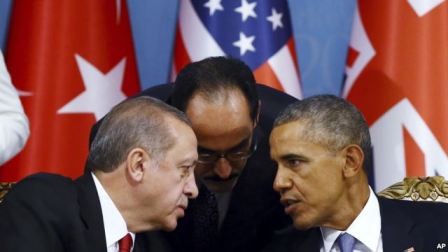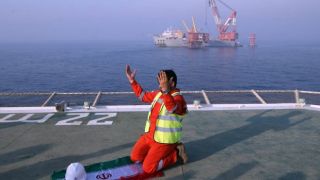Turkey’s provocation against the Russian bomber has spoiled the United States’ plans in the Middle East.
Since Nov 24, we have heard lots of stories about that incident. The most popular one says that it was a U.S.-Turkish plot against Russia. The Americans and the Turks were actually preparing a “surprise” for the Russians in Syria, but the Turks let their allies down, thereby proving once again that they are unpredictable even for close partners.
▼ читать продолжение новости ▼After the terrorist attacks in Paris on Nov 13, the allies met at the G20 summit in Antalya with a view to coordinate their further actions in Syria. Besides discussing the plan to create a 100-km wide buffer line between Jarabulus and Aazaz (the Turks are planning to extend this line westward to the Mediterranean), Barack Obama and Recep Tayyip Erdogan agreed to launch a joint fire attack on the ISIL’s northern and northwestern positions. They meant Aleppo and Idlib, where Bashar al-Assad’s forces, together with Iranian volunteers and Lebanese Hezbollah fighters, are fighting terrorists from the ISIL and the al-Nusra Front. Without Russian bombers, the Syrians would have had rough times there.
▼ читать продолжение новости ▼The meaning of the U.S.-Turkish “surprise” was that officially the allies were planning to strike the ISIL but in reality they would also brush against the Syrian troops. In fact, they were plotting something they kept accusing the Russians of for weeks. Their logic was simple: the Russians are bombing mostly “moderate” Syrian oppositionists, why can’t we do the same. That is, their goal was to use the attack against the ISIL for curbing the offensive of the Syrian government forces. The Turks were keen to do that – for they are really enraged to see Iranians and Russians effectively fighting in Syria, while they have no legal rights to do anything there.
Right after Obama and Erdogan reached an agreement at a meeting in Antalya (1), on Nov 16, the Americans sent a group of air-capable ships from Norfolk, Virginia, to the Gulf. Before reaching the destination, the Harry S. Truman and accompanying ships (2) were supposed to launch cruise missiles against some targets in Syria. Probably, they planned to raise warplanes from the aircraft carrier to hit targets in Syria. Simultaneously, the Turkish air forces, jointly with the Incirlik-based U.S F-15s and A-10s, were supposed to strike the north of the country.
The key goal of the campaign was to cut the Russians down to size. The allies were really annoyed to see launches of Russian cruise missiles from the Mediterranean and Caspian seas, Russian long-range air forces acting in Syria. Besides, the Americans were worried about the safety of civil flights over Lebanon – for, according to Washington analysts, on Nov 20 the Russians allegedly asked the Lebanese authorities to suspend all civil flights in Lebanon for 72 hours as they were planning to launch missiles from the eastern part of the Mediterranean (3).
The Americans were planning to place the Russians to their size, but they forgot what a partner they had. The Turks’ attack on the Russian Su-24 was a surprise to them. In Antalya, Erdogan might well inform Obama that Russian bombers were “violating” Turkish borders and that he had to react in some way. But Obama hardly expected such a reaction – for he is not as far from reality as some Turkish leaders are and was perfectly aware of what the Russians’ could do in response.
The last thing the U.S. president would like to see in the region was S-400 anti-aircraft missiles. So, the transfer of Russian Triumfs to Latakia was a kind of a defeat for the Americans. Their carriers were not even close to the Mediterranean when they faced the first obstacles.
So, now the Americans will have to avoid unnecessary encounters with Russians bombers in Syria. We doubt that the crew of their Truman will be happy to know that once they take off from the carrier, they will be detected by S-400. In fact, the Turks have left their allies holding the baby.
Wrecked talks on Syria are not at all what Obama wants. And it is all but pleasant to him to hear them in the Kremlin saying that the Americans are unable to fulfill their agreements with the Russians – for under the memorandum on safety of flights during the campaign in Syria, they pledged to guarantee that their anti-Jihadist partners would not cause incidents like the one caused by Turkey.
We can’t say for sure that Erdogan let Obama down deliberately. But this is also possible. The Turks would not mind a growing confrontation between the Americans and the Russians in Syria. They perfectly realize that any joint U.S.-Russian effort against ISIL would be against them. Their biggest fear is that one more “Iraqi Kurdistan” may be created in the north of Syria. For their assistance in dethroning Saddam Hussein the Iraqi Kurds were granted autonomy. So, the same may well happen in Syria - especially as both the United States and Russia recognize the Syrian Kurds’ right to autonomy. So, the Turks’ hysterical behavior is easy to understand.
The current Turkish authorities are acting quite provocatively. And they might well do what they did on Nov 24 just to set the United States and Russia against each other. The other goal of the Nov 24 provocation might be to spoil the Russian-French plans to act jointly in Syria – for the French Charles de Gaulle aircraft carrier was already going to the Gulf to get in touch with the Moskva missile cruiser.
The Americans’ reaction to the Nov 24 incident proves that it was unexpected to them. They first expressed concern that ISIL fighters were quite active on the Turkish-Syrian border and urged the Turks to send additional troops there. The Wall Street Journal quotes U.S. officials as saying that a bigger Turkish border deployment—including infantry and artillery units—would be the most realistic way to close off key transit routes on which Islamic State fighters in Syria rely and stem the flow of foreign fighters into Europe.
The Americans’ second counter-step was their criticism of the Turks’ growing aggression against Kurds – for instead of deploying more forces against the ISIL, the Turks continue attacking Syrian and Turkish Kurds – the two key opponents of the Islamic State. “So, are you with us or not?” ask the straightforward Americans.
And they also suspect the Turks of playing double and using some ISIL commanders in their interests. In fact, the Americans have lots of proofs that some Turkish leaders are contacting the ISIL. Even after the meeting of Obama and Erdogan in Antalya, U.S. mass media continued reporting some deep contradictions between the sides.
Some of them are sure that there are certain ISIL supporters in the Turkish government and security service. This is one of the key reasons why the United States refuses to let Turkey to freely fly in the north of Syria. The arrival of the Russians has made the Turks unbidden guests and potential targets in northern Syria.
Though not cancelled, the joint U.S.-Turkish campaign in Syria will probably need some revisions. For the time being U.S. and Turkish ships (Carney (DDG 64), Dolunay and Burakreis) are watching the Moskva missile cruiser round-the-clock. What they will do when Harry S. Truman reaches the Mediterranean is hard to predict.
But whatever the Americans are planning to do in Syria, they will no longer trust their Turkish allies. Once again after the Iraqi campaign of 2003 the Turks preferred their own game to their alliance with the United States.
It was typical Turkish behavior to shoot down a plane and then to ask NATO to cover up the provocation. The Turks have acted like this since the Ottoman times, when instead of NATO there was the British Empire.
The current Turkish neo-Ottomans have opted for provocations as a way to turn things in Syria to their advantage. The reactive policy the Turkish authorities apply at home – when even in order to tone up their own people they may even organize terrorist acts (like the ones in Suruc and Ankara) – is now being shifted to Syria. Strangely enough, after the Nov 1 presidential elections in Turkey, the ISIL stopped being active in that country and is now appearing spontaneously, only when the Turks need to strike their domestic enemies – the Kurds and the opposition.
Erdogan and his team are very much afraid of a civil war in their country and are doing all they can to shift it to their southern borders.
So, EADaily’s forecast is coming true. The Turkish leaders are turning themselves into regional outcasts as during the five years of his rule Erdogan has shattered the confidence of Greece, Armenia, Syria, Iraq, Iran, Israel and now Russia. And the next on this list may be the United States.
(1) It should be noted, the work had been done before it at the level of presidential aides of USA and Turkey and their military institutions since Sept 30. It was quite intensive and hided from the media.
(2) Destroyer Squadron 28, Anzio, Bulkeley and Gravely cruisers, as well as Gonzalez (DDG 66) destroyer.
(3) Ryan T. Tewell, US Carrier Deployment Opens a Strategic Opportunity in the Mediterranean // The Washington Institute for Near East Policy, November 23, 2015.
EADaily Middle East Bureau

 White House: Trump is unhappy with Putin and Zelensky's statements about the conflict
White House: Trump is unhappy with Putin and Zelensky's statements about the conflict Rostransnadzor has slowed down the export of Kazakh oil
Rostransnadzor has slowed down the export of Kazakh oil Three US soldiers missing during exercises in Lithuania are dead, the fourth is being sought
Three US soldiers missing during exercises in Lithuania are dead, the fourth is being sought For criticizing Zelensky, a Ukrainian human rights activist was arrested in Poland and transferred to Kiev
For criticizing Zelensky, a Ukrainian human rights activist was arrested in Poland and transferred to Kiev Podolyaka: The interests of Islamists in Russia are lobbied at the highest level
Podolyaka: The interests of Islamists in Russia are lobbied at the highest level "Die, but don't give up Gyumri!": opposition gave battle to Pashinyan's party in local elections
"Die, but don't give up Gyumri!": opposition gave battle to Pashinyan's party in local elections